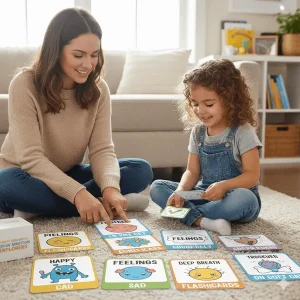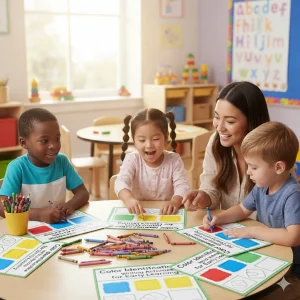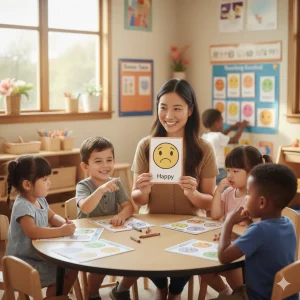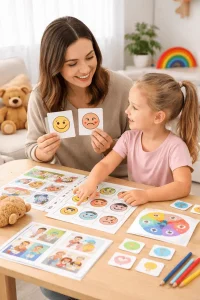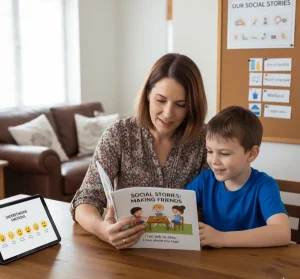The Importance of Baby Cues: How to Prevent Still Face Syndrome
Last Updated: January 16, 2025
As a parent, you’re probably constantly observing your baby for clues on how they’re feeling, what they need, or even just what they’re thinking. These little expressions, sounds, and gestures that your baby makes, often called baby cues, are their way of communicating with you. They may not have words yet, but they have plenty to say through their body language and facial expressions. It’s essential to understand these cues to recognize early signs of Still Face Syndrome.
From the moment they’re born, babies rely on their parents or caregivers to respond to their cues. Whether it’s a smile that lights up their face when they see you, or a cry signaling hunger or discomfort, these interactions play a vital role in their emotional development. By responding to these cues, you’re not just addressing their immediate needs, you’re also helping them feel secure, understood, and emotionally connected.
What is Still Face Syndrome?
Still Face Syndrome is a psychological phenomenon that occurs when a baby receives no emotional response or feedback from a caregiver. Babies naturally rely on their caregivers’ facial expressions, voice, and body language to feel connected, secure, and understood. When these responses are absent, it can create confusion and distress for the baby.
This concept was first explored in the Still Face Experiment, a landmark study conducted by Dr. Edward Tronick in the 1970s. In this experiment, a parent was instructed to interact with their baby as usual—smiling, making eye contact, and engaging. Then, the parent was asked to stop responding entirely, maintaining a blank, expressionless face, often referred to as the “still face.” The baby, after trying to re-engage the parent, quickly became distressed—crying, fussing, or looking away.
Read More: How Still Face Syndrome Affects Your Child’s Emotional Health
The Still Face Experiment demonstrated how deeply babies are affected by the emotional responses of their caregivers. Without the emotional feedback they expect, babies experience stress, confusion, and a sense of abandonment. Over time, if a caregiver frequently ignores these emotional cues, the baby might begin to feel emotionally disconnected, a core issue of Still Face Syndrome.
Still Face Syndrome doesn’t just affect a baby in the moment. The absence of emotional responses can impact a baby’s emotional and social development. Babies thrive on emotional interaction—it’s through this interaction that they learn to bond, feel secure, and begin developing social skills. When that connection is repeatedly interrupted or absent, a baby may struggle with emotional regulation, face difficulties in forming healthy attachments, and even experience delays in social development.
Why Are Baby’s Cues So Important?
From the moment they’re born, babies have an incredible ability to communicate, even though they can’t use words yet. These early forms of communication, often referred to as baby cues, include things like smiles, cooing, crying, reaching out, and various facial expressions. Each of these actions is a way for your baby to tell you something—whether it’s a need for comfort, hunger, or simply a desire for interaction.
For example, a smile may show happiness or recognition, while crying might indicate that your baby is hungry, tired, or uncomfortable. Babies might coo when they’re content or reach out to connect with you physically, signaling their need for closeness. Even subtle changes in facial expressions can be powerful indicators of their emotional state.
Responding to these cues is essential because it lays the foundation for your baby’s emotional development. When you acknowledge and respond to your baby’s signals—whether by picking them up, smiling back, or soothing them when they cry—you are teaching them that their emotions are understood and validated. This kind of interaction helps create a healthy emotional connection between you and your child.
The Impact of Ignoring Baby’s Signals
As a parent, it’s easy to get overwhelmed, and sometimes, it might seem harmless to miss or ignore your baby’s cues. However, not responding to your baby’s signals can have significant consequences on their emotional and developmental growth.
When you consistently ignore your baby’s cues, it can lead to emotional neglect. Babies depend on you to understand and respond to their needs—whether they’re hungry, tired, or just want comfort. Ignoring these needs can make them feel unseen and unheard, leading to feelings of insecurity. Over time, this emotional neglect can damage their ability to trust others and form healthy relationships.
One of the immediate reactions to being ignored is stress and anxiety in your baby. Imagine trying to communicate your feelings or needs and getting no response—it’s confusing, frustrating, and distressing. Babies experience the same emotions when their signals go unnoticed. This stress can cause them to cry more, withdraw from interaction, or become increasingly fussy. In the long run, prolonged stress can affect your baby’s ability to regulate emotions, causing them to become more anxious or emotionally reactive.
Recognizing Signs of Still Face Syndrome
It’s important to understand the signs of Still Face Syndrome so that you can respond and support your baby before any long-term emotional effects take root. Babies are incredibly sensitive to the emotional feedback they receive from their caregivers, and when that connection is disrupted, there are clear indicators that something isn’t quite right.
Here’s how you can identify if your baby is experiencing Still Face Syndrome:
- Baby becomes withdrawn
One of the first signs you might notice is that your baby becomes less expressive and seems disengaged. If your baby was once full of smiles and sounds, but now appears distant, this could be an early indicator of Still Face Syndrome. Withdrawal happens because the baby feels like their attempts to connect aren’t being acknowledged, causing them to stop trying to engage emotionally. - Lack of eye contact
Babies naturally seek eye contact with their caregivers as a way of connecting and bonding. If you notice that your baby avoids looking at you, especially during moments when they would normally engage, it could be a sign that they’re feeling emotionally disconnected. This lack of eye contact can signal that they no longer expect a response and have stopped looking for one. - Reduced smiling or engagement
Smiling is one of the primary ways babies express joy and recognition, and it’s an important part of early bonding. If your baby is smiling less or seems less responsive to your smiles, they might be struggling with feelings of disconnection. Similarly, a general lack of engagement—such as not reaching out for you or interacting with toys—can indicate emotional withdrawal. - Increased fussiness or stress
When babies don’t receive the emotional connection they need, they often express this through increased fussiness, crying, or visible signs of stress. You might notice that your baby becomes more irritable, harder to soothe, or exhibits more frequent mood swings. These signs can be a direct result of feeling emotionally abandoned, leading to heightened anxiety and stress.
Signs of Still Face Syndrome
| Sign | Description |
|---|---|
| Withdrawal | The baby appears less interested in engaging with caregivers. They may seem detached or emotionally distant, avoiding interaction or play they once enjoyed. |
| Lack of Eye Contact | Babies naturally seek eye contact as a way of connecting with their caregivers. A noticeable decrease or complete avoidance of eye contact can signal distress. |
| Reduced Smiling | Babies typically smile when they feel happy or recognize a familiar face. If your baby stops smiling or reacting to your smiles, it may indicate emotional disconnection. |
| Increased Fussiness | Babies experiencing emotional neglect often show heightened irritability or fussiness. They may cry more frequently and be harder to calm down or soothe. |
How to Respond to Your Baby’s Cues and Prevent Still Face Syndrome
Now that we’ve explored the importance of baby cues and the impact of Still Face Syndrome, let’s focus on practical ways you can prevent it by responding to your baby’s signals. It’s not about being perfect—it’s about being present. When you respond to your baby’s cues, you’re letting them know they are seen, heard, and valued. Here are some simple but effective tips for making sure you’re staying connected with your baby.
Know more about on Identifying and Managing Still Face Syndrome in Children
1. Pay Attention to Your Baby’s Cues
Your baby communicates through little gestures, facial expressions, sounds, and movements. Whether it’s smiling, cooing, or crying, these are their ways of reaching out to you. By noticing and interpreting these cues, you can better understand what your baby needs at any given moment. If they’re smiling or making eye contact, they may want to engage with you. If they’re crying or frowning, it could mean discomfort or a need for comfort.
2. Respond with Affection
Whenever your baby smiles, coos, or reaches out, respond with warmth and affection. Talk to them, smile back, and hold them close when they seem to need it. Physical touch, eye contact, and soothing tones are all powerful ways to reinforce emotional security. This back-and-forth interaction teaches your baby that they can trust you to respond to their needs, which strengthens your bond and helps them feel safe.
3. Make Time for Face-to-Face Interactions
In the hustle of everyday life, it’s easy to get caught up in tasks. However, taking time for face-to-face interactions is crucial for building emotional bonds. Simple activities like making eye contact while you talk to your baby, playing peekaboo, or gently touching their face while they gaze at you can make a huge difference in their emotional development. These moments of connection are essential for helping them learn how to engage with others emotionally.
4. Avoid Distractions
Distractions like phones, stress, or multitasking can cause us to miss important cues from our babies. It’s easy to get wrapped up in replying to a message or thinking about work, but it’s important to set aside moments to be fully present with your baby. Try to minimize distractions during key bonding moments, like feeding, playtime, or when your baby is trying to engage with you. By being present, you’re letting your baby know they have your full attention, which reassures them emotionally.
5. Bonding Activities
Engaging in bonding activities with your baby is one of the best ways to strengthen your connection and help them develop emotionally. Singing to your baby, reading them a story, or playing simple games like pat-a-cake are all ways to interact meaningfully. Responsive caregiving—like comforting them when they cry or laughing with them during play—helps them learn about emotional give-and-take, which is key to their development.
Conclusion
Your baby’s emotional development depends a lot on how you respond to their cues. Whether it’s a smile, a cry, or a little coo, these signals are your baby’s way of communicating with you. By recognizing and responding to them, you help your baby feel secure, loved, and understood. When babies feel connected this way, they are more likely to grow up with healthy emotional and social skills. Ignoring these cues, however, can lead to emotional disconnection, such as Still Face Syndrome, where your baby may feel neglected or unseen. At Wellness Hub, we offer resources to help you strengthen your bond with your baby, ensuring they grow in a nurturing, supportive environment.
Frequently Asked Questions:
1. What is Still Face Syndrome?
Still Face Syndrome is a psychological phenomenon where a baby feels emotionally disconnected when they don’t receive any response from their caregiver. This lack of interaction can lead to feelings of stress, withdrawal, and confusion for the baby.
2. Why are baby cues important?
Baby cues, such as smiling, crying, or cooing, are how babies communicate their needs and emotions. Responding to these cues helps build a strong emotional bond, making babies feel safe, understood, and connected to their caregivers.
3. What are the signs of Still Face Syndrome in babies?
Signs of Still Face Syndrome include a baby becoming withdrawn, avoiding eye contact, reduced smiling or engagement, and increased fussiness or stress. These behaviors indicate that the baby may be feeling emotionally disconnected.
4. How can parents prevent Still Face Syndrome?
Parents can prevent Still Face Syndrome by responding to their baby’s emotional cues, maintaining regular face-to-face interactions, and engaging in bonding activities like singing, playing, or reading. Avoiding distractions, such as phone use, is also important.
5. What happens if I ignore my baby’s cues?
Ignoring your baby’s cues can lead to emotional neglect, increased stress, and potential developmental delays. Over time, this may result in emotional disconnection, where the baby may feel unseen or abandoned, leading to issues like Still Face Syndrome.
6. How do bonding activities help my baby’s emotional development?
Bonding activities, like cuddling, talking, and playing, help babies feel emotionally secure and connected to their parents. These activities teach babies about trust, empathy, and communication, which are key to healthy emotional and social development.
7. Can using my phone while caring for my baby affect their emotional development?
Yes, distractions like phone use can cause you to miss important baby cues, leading to emotional disconnection. Being fully present during interactions helps your baby feel seen and valued, which is crucial for their emotional development.
8. How can I improve my baby’s emotional connection?
You can improve your baby’s emotional connection by regularly responding to their cues, engaging in face-to-face interactions, and participating in activities that strengthen your bond. Consistent emotional responses help build a strong foundation for your baby’s well-being.
9. How does emotional neglect affect a baby’s development?
Emotional neglect occurs when a baby’s emotional needs are not met through interaction and responsiveness. Over time, this can cause babies to feel insecure, anxious, and disconnected, leading to potential emotional, social, and cognitive developmental delays.
10. How can I tell if my baby is trying to communicate through cues?
Babies communicate through various cues like smiling, cooing, crying, and reaching out. These signals show their need for attention, comfort, or engagement. Paying close attention to these behaviors and responding with affection helps build a strong emotional connection and fosters their development.
About Author:
Lasya Vooturi,
Clinical Psychologist (A) & Behavioral Therapist
Lasya holds a Professional Diploma in Clinical Psychology from Amity University, where she deepened her understanding of psychological principles from March 2023 to March 2024. With over a year of dedicated experience as a Behavioral Therapist, Lasya has honed her skills in applying effective therapy techniques tailored to individual needs. Fluent in Telugu, Hindi, and English, she is adept at connecting with a diverse range of clients, ensuring comprehensive communication and understanding. Lasya’s approach is grounded in empathy and scientific rigor, making her a trusted ally in navigating mental health challenges.
Book your Free Consultation Today
Parent/Caregiver Info:
Client’s Details:
* Error Message
